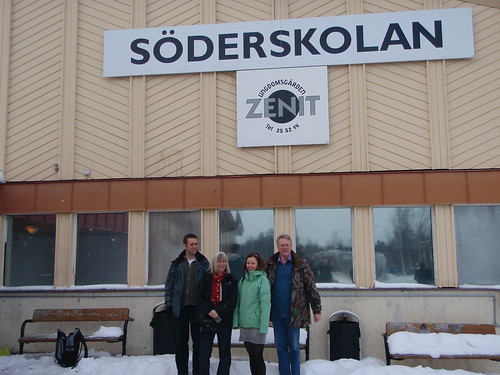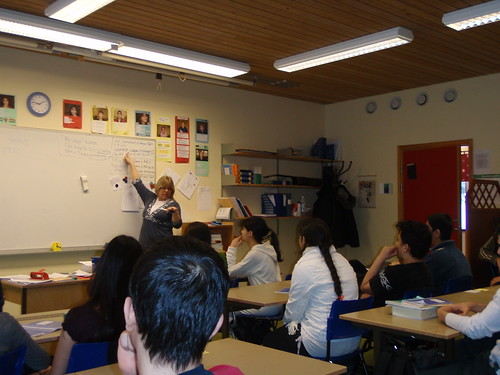This morning began (bright and early at 8am having not got to the hotel until half-past midnight) at Sandviken's Education Offices, with an introductory talk about the education system in Sweden and Sandviken's history of using ICT in schools. It seems that historically Sweden was a leader in the use of ICT in schools, Sandviken particularly, with a large number of projects taking place and a high level of investment since 1994. However, this is not now quite the case due to political and funding changes. However, the team and Sandviken are keen to ensure that ICT continues to be used to support teaching and learning.
The school visited today was 'Soderskolen', a Secondary and Middle school teaching grades 4-9 (roughly age equivalent to years 6-11 in the English system).

The first thing that struck me was the size of the school - less than 400 pupils in the Secondary and 250 in middle school, which is apparently the norm for Swedish Secondary schools. Along with this you noticed the general level of calm in the building. There was an extremely relaxed atmosphere and the relationship between pupils and teachers seems extremely good humoured, but with a clear respect for boundaries.
The first class we visited was a textiles / DT class where the teacher showed us the system for E-Portfolios. This is a system that allows pupils to submit their work online fot teacher to mark and comment upon, accessed from a regular webpage, and where the pupils build up an e-portfolio. A nice feature of the system is that children can choose if they wish to make their finished work public to be viewable on the 'inspirations' section of the site. This can then be seen by anyone who cares to visit the website and builds into a great resource to give children ideas for their own work as well as giving them an instant wide audience.
Another point of interest in the school visited today was the attitude to mobile phones. Most of the children had them on their desks in front of them and when asked said they did not get into to trouble if they went off during a lesson; in fact they could go out of the class to take a call if necessary! Also, the teacher in the Science class we visited had the phone numbers of the students – it was not uncommon for them to text him or he to text them outside of school hours.
In the middle school class we visited the teacher had recently returned from her visit to BETT. She had brought back with her some of the 2simple software titles to try out, particularly 2animate and 2DIY. As ever the children seemed to enjoy 2DIY and were keenly making their own platform games, although had not explored much of the rest of the program. Most of the teachers we are travelling with had not seen the product before and there were some interesting conversations about its potential for supporting cross-curricular learning. I have promised to show it to them on my laptop and let them have a play with it before the week is out.

The final class of the day visited was a second language group. The majority of the children were Iraqi and a few from Burma. The children spend all of their time initially with this group, and are introduced to Swedish and English lessons immediately. After the first few weeks the children are integrated into mainstream classes for lessons that are not as ‘language heavy’ such as Art, PE etc. and gradually into more mainstream classes for all subjects. Even when they integrate into Swedish lessons and are assessed alongside native speakers allowances are made for their grammar, spelling etc. The teachers ‘reward experimentation’, preferring to see children challenge themselves in their writing and make mistakes rather than play it safe and produce simple writing that is grammatically and spelt correct.

Quote of the day came from the science teacher whose class we visited. He mentioned that the children sometimes produced videos as homework to reinforce learning that happens in the classroom;
“They are making videos about their sex education. I have only seen small parts so far.”





1 comment:
Hi, Steven,
When you get back I would like to talk with you more about how an e-Portfolio system can be set up cheaply and at no serious effort for teaching staff or technicians.
see my blog at:
www.efoliointheuk.blogsport.com
Post a Comment